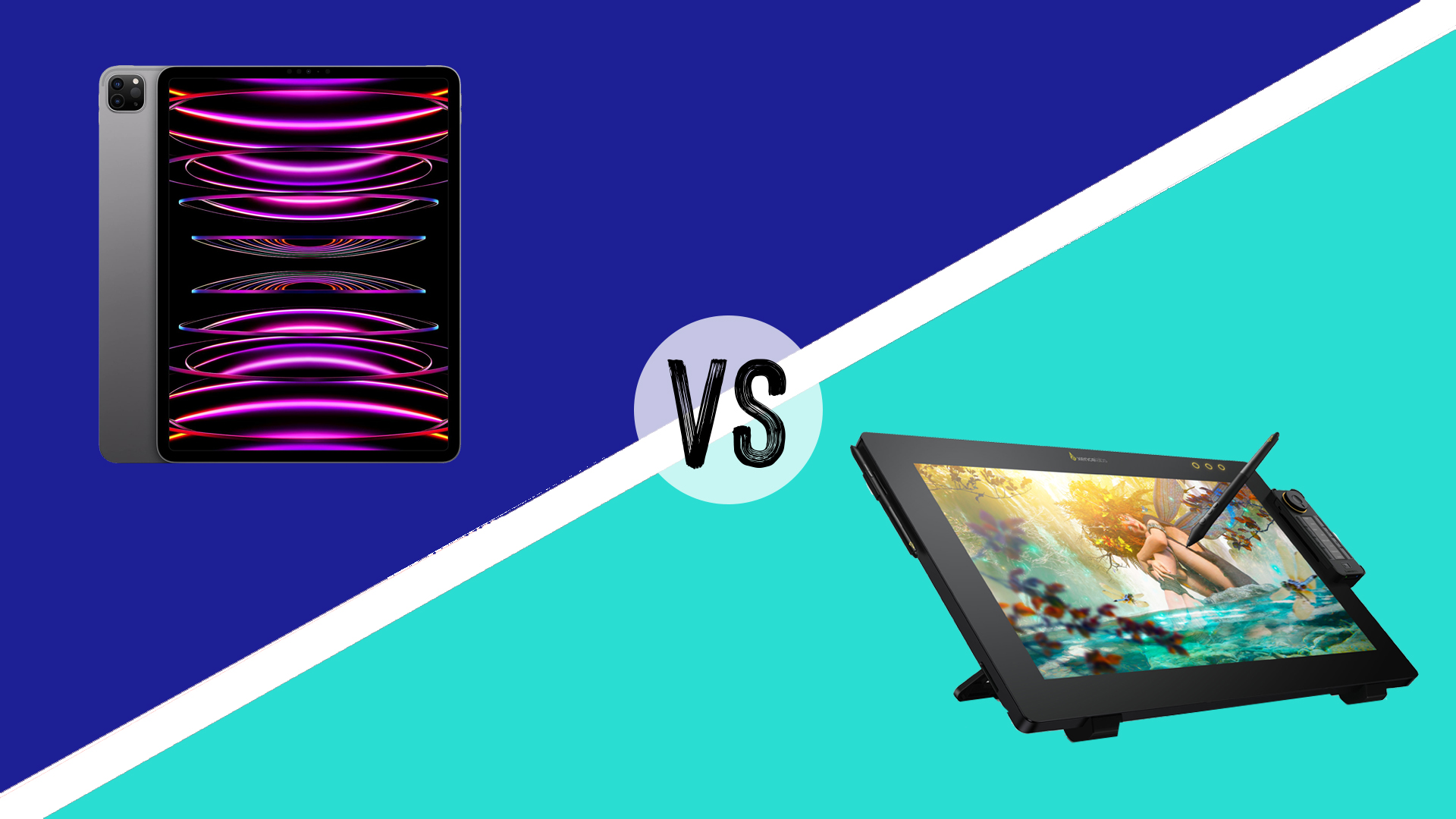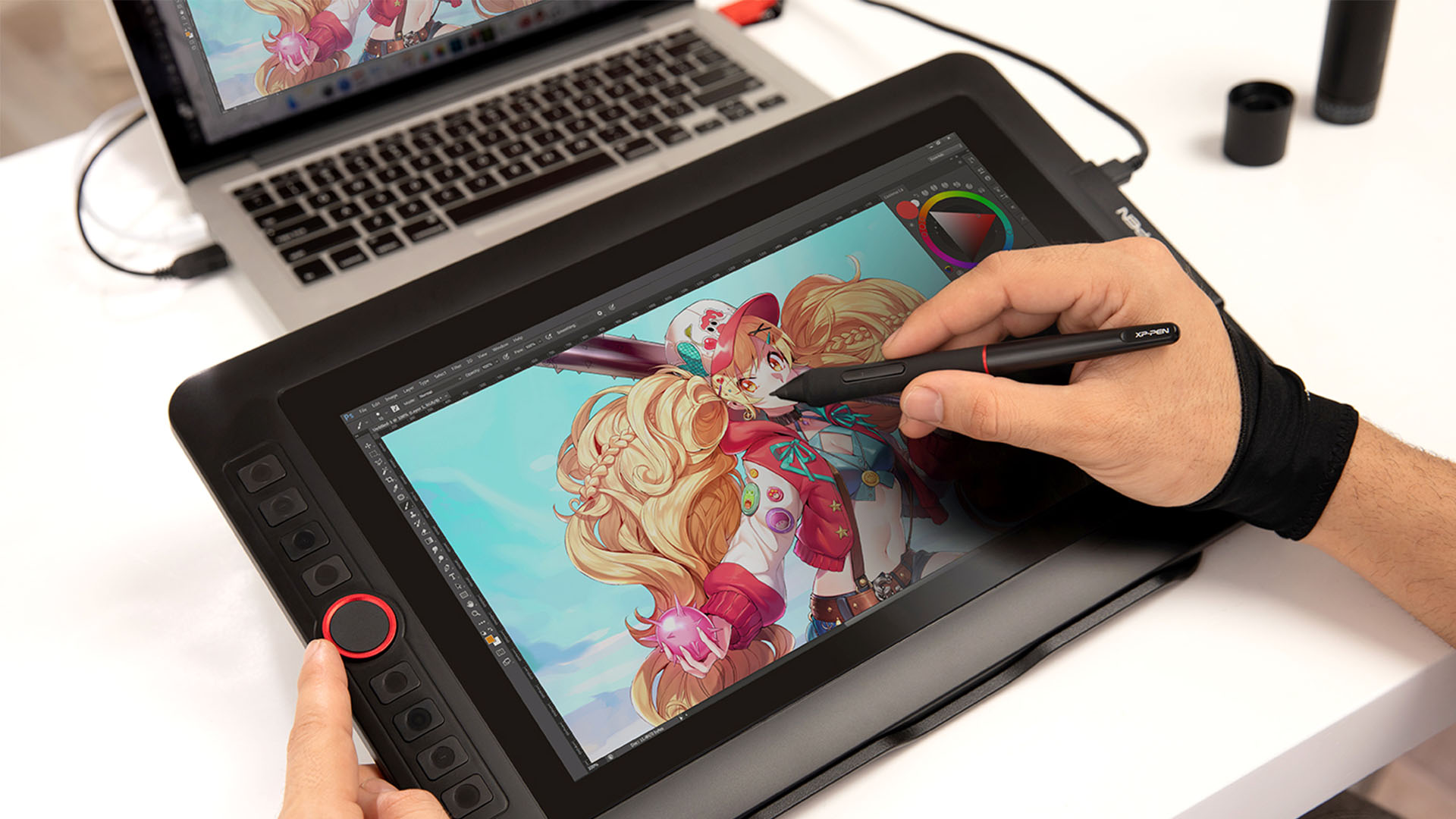iPad vs drawing tablets: which one should you get?
We compare the pros and cons of choosing an iPad vs a drawing tablet for digital art.

iPad vs drawing tablet can be a tough decision for digital artists. We've reviewed all of the iPad generations as well as many of the best drawing tablets, and they all have their strengths. Drawing tablets are specialist devices designed especially with digital art in mind, but the best iPads for drawing have the benefit of being more versatile, serving for other tasks as well as creating art with an Apple Pencil.
There are pros and cons for each type of drawing tablet. For creatives that need to do more than drawing alone, Apple's iPad Pro may be ideal. Meanwhile, some illustrators and artists will want a purpose-built drawing tablet with a larger screen. It all boils down to your own preferences on display size, stylus, app and software compatibility, ease of use, desk space, and of course your budget. Here we compare the pros and cons of each.
iPad vs drawing tablet: Features
Drawing tablets
Traditional drawing tablets (or pen displays) are a popular choice and generally suitable for dedicated digital artists, although they aren't the best for on-the-go use, as they need to be hooked up to an external computer, laptop, or monitor so you can see what you're doing (though many now run off smartphones). We've covered a lot of these tablets in our best budget drawing tablets guide, but most of these picks are targeted at beginners and not pro-level artists.
If you have a work-from-home setup or home studio space already equipped with one of the best 4K monitors, then a drawing tablet without a display is a great and easy-to-use option that will complete your setup at a reasonable price.

You can of course get a portable monitor to pair with your drawing tablet should you need to work outside, or you could use your laptop if you're on the train, or smartphone (but apps are limited). But if having a portable setup is crucial to you then it might be wise to invest in either a pen display tablet (see below) with its own screen built-in (but it still needs a computer), or an iPad instead.
If you're set on a drawing tablet, then we recommend the Xencelabs Pen Tablet Medium (check out our review) as our top pick for the best overall value and build quality. We gave it a 10/10 rating and recommend it for illustrators, digital painters and photographers.
However, if you want something even more budget-friendly, we'd recommend the Huion Inspiroy Dial 2, the tiny Xencelabs Pen Tablet Small or for a slightly more modern pen tablet, the Wacom Intuos Pro is a great choice. See the lowest Wacom One Prices for the best deals on this leading brand's newest budget drawing tablets.
Pen Displays
Pen displays are another type of drawing tablet that are equipped with their own built-in screens. A lot of pen displays are considered to be pro-level, and are much costlier than your basic drawing tablet, with advanced designs and features for artists.
The benefit of choosing a pen display over a screenless drawing tablet or iPad Pro is that they tend to have larger screens (up to 24 inches), can run full software programs such as Adobe Photoshop (because these still run off a laptop), and arguably have better stylus options, with more pressure sensitivity, compared with using a stylus on an iPad (the new XPPen's new Artist Pro (Gen 2) series has 16,384 levels of pressure).
These display tablets also boast other neat design features such as handy quick keys for software shortcuts, the stylus can be calibrated with the display for improved accuracy, and colours are brighter too thanks to the higher colour gamut.

The downside to pen displays is the premium price, as well as a more complex setup process that can be off-putting to beginners. You also can't use the digital art software Procreate or Procreate Dreams, available only on iPad. But if you travel frequently and need a lightweight and portable setup then you should probably avoid a pen display drawing tablet.
We would recommend the Xencelabs Pen Display 24-inch tablet as our top pick for a luxury drawing experience, but this display can be considered too big for a lot of creatives. Other options include the expensive Wacom Cintiq 22, ideal for students when paired with the Wacom Pro Pen 2, and lastly the XP-Pen Artist Pro 16 (2nd gen) as a mid-range option for those who have a looser budget.
A quick word on pen computers - these are all-in-one displays with high-spec GPU and CPU configurations designed to run 3D software, CAD and 2D software. These are essentially a powerful Intel i7 laptop with a Wacom screen and stylus. If you're serious about digital art, are creating animation and 3D art using full software suites such as Blender, Unreal Engine 5 and Cinema 4D, ZBrush and what to replace a laptop on your desk, then the Wacom MobileStudio Pro 16 ($3,499.95) or Huion Kamvas Studio 24 ($2,399) are the current picks.
iPad
The iPad is a tablet computer rather than a dedicated drawing device, but with Apple Pencil support, it can serve for drawing very well. There are several models, but for digital artists we would suggest the iPad Pro 12.9-inch (M2, 2022) if your budget covers it. You can also get away with the iPad Air (5th gen, 2022), but the iPad Pro has a larger, brighter screen.
One of the biggest sells for iPads as tablets for drawing is that they can also do so much more. As well as running a range of digital art software, you can use them to browse the internet, watch films, answer emails, take video calls and edit photos and videos and more. And while iPad Pros might seem expensive, this actually makes them quite good value when you consider all they can do. The Wacom MobileStudio Pro 13 costs $2,599.95, $300 more than the iPad Pro 12.9-inch (6th Gen). See our best iPad for Procreate guide for digital-art specific iPad recommendations.

The easy-to-use touch screen and gesture controls with the iPad are great for those already familiar with and accustomed to Apple products. Another plus is Procreate software, which is exclusive to the iPad,
Just a couple of things to bear in mind. iPad runs iPad OS, so you're limited to mobile apps unless you use software to screen mirror. iPads can also benefit from a matt cover for the screen, such as Rock Paper Pencil, to avoid any unwanted gliding around the glossy screen as you draw, as well as preventing damage and wear to both the screen and Apple Pencil.
iPad vs Drawing Tablet: Price

One of our favourite pen displays, the Wacom Cintiq 16, retails for around $649.95/£529. However, Wacom also has the Wacom One budget pen display, with prices as low as $399.95.
Lesser known brands like Xencelabs, Huion and XP-Pen often have good prices. We think Xencelabs' Pen Display 24 Studio Series is the ultimate Wacom destroyer as a more pro pen display. It can be had for a price of $1,899/£1,850 compared with the Wacom Cintiq Pro 24 which retails for $2,199.95/££1,949.00.
Drawing tablets (devices that require a separate screen) come cheaper. Here the Wacom Intuos (Small) pen tablet costs just $69.95 and can be discounted as low as $39.95.
As for the latest M2 iPad Pro model, this usually retails at $1,099/£1,249 for the entry-level specs. The best iPad Pro 12.9 prices and deals tend to fluctuate a lot throughout the year.
You can compare prices in your region in the table below.
Daily design news, reviews, how-tos and more, as picked by the editors.

Beth is Creative Bloq’s Ecommerce Writer and has the fun job of finding you the very best prices and deals on creative tech. Beth kicked off her journalistic career writing for Digital Camera World and has since earned bylines on TechRadar and PetsRadar too. With a Master's degree in Photography, Beth loves getting to tinker with new cameras, especially camera phones, as the resident Samsung fan on the team.
